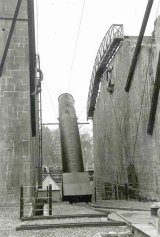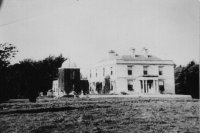
photo courtesy of
Barry Pickup
by James O'Connor
 |
| The Restored 6-foot Rosse Telescope as it appears today.
photo courtesy of Barry Pickup |
The Observatory was founded in 1827 at his estate at Birr, Co. Offaly (about 80 miles west of Dublin) by William Parsons, heir to the Second Earl of Rosse and who later became the Third Earl. Finding himself, at the age of 27, in the possession of leisure, extensive means and great mechanical ability, he decided to devote himself to the construction of large telescopes. These were all reflectors, involving the use of "speculum metal", an alloy of copper and tin. A 3- foot (0.915m) instrument was completed in 1839, followed by a 6-foot (1.83m), the "Leviathan of Birr" in 1845. This instrument became world famous and remained the largest telescope in the world until dismantled in the early part of the 20th century.
Engineering constraints dictated that the 6-foot be mounted between two walls, which had the effect of restricting its use to areas of sky close to the meridian. Nevertheless the instrument, under the Third Earl and his son, the Fourth Earl, was responsible for many discoveries, the most notable of which was the spiral structure of many galaxies (at that time included under the general title of "nebulae").
A pioneering experiment, carried out in 1868 with the 3-foot instrument, was the measurement of the temperature of the moon. The drop in the moon's temperature drop during lunar eclipses was also accurately measured.
Coated aluminium, rather than speculum metal, is used for the recently restored instrument. The original speculum mirror may be seen at the British Science Museum, South Kensington, London.
A lunar crater (in the Mare Nectaris, NE of Fracastorius) is named "Rosse", after the Third Earl.
 |
| Daramona Observatory about 1900.
photo from the archives of J.C. McConnell |
Wilson's first instrument was a 12-inch (30.5 cm) reflector made by Howard Grubb of Dublin. This was followed in 1881 by one of 2 feet (61 cm) diameter. Electrical controls were added to this second instrument in 1891 in order to facilitate astronomical photography. With this equipment he made photographic observations of stellar transits as well as making many superb photographs of clusters and nebulae. In 1902 he developed a method of determining the temperature of the solar photosphere by balancing the amount of solar radiation against the radiation from an electrically heated strip of platinum. The temperature obtained (5900K) was very close to the true value. His scientific work was recognised by his election as Fellow of the Royal Society in 1896 and by the conferring of an honorary degree of Doctor of Science by Dublin University in 1901.
Wilson died in 1908 and the observatory then closed.
Dr Wentworth Erck and Sherrington Observatory: Dr Erck was the son of an Ecclesiastical
Commissioner for Ireland and, after studying for the bar, became magistrate for Co Wicklow. He
developed an interest in astronomy in his early youth and decided to set up an observatory at his
home at Sherrington, Bray. This he equipped with a 7.5-inch (23 cm) refractor and a 15-inch
(46 cm) reflector.
He used his equipment extensively, chiefly on the sun and planets. He has left records of the
appearance of the sun's disc on a great number of days from 1869 to 1888. He appears to have
been among the first to notice the movement of the Great Red Spot of Jupiter with respect to
other features on the planet. He contributed extensively to contemporary scientific journals.
On his death in 1890 observations ceased at Sherrington. The 7.5-inch refractor appears to have
passed into the hands of the Dublin observer William Monck. (See below.)
John Birmingham and Millbrook Observatory: Millbrook Observatory was founded by John
Birmingham, a country gentleman residing near Tuam, Co Galway. Although his only
equipment was a 4.5-inch (11 cm) refractor he achieved early success by the discovery of the
recurrent nova T Coronae in 1866. He discovered a variable star in Cygnus in 1881.
Starting in 1872 and acting on the suggestion of his English contemporary, the Rev. T. Webb, he
undertook, from his own observations, a revision of Schjellerup's Red Star Catalogue. The
project ended with the publication in 1877 of an expanded list of 658 red stars, incorporating
observations by Schmidt, d'Arrest, Webb, Secchi and Herschel as well as his own.
In addition to his work on variable and red stars, he published papers on sunspots, meteor
showers and the 1874 transit of Venus. On his death in 1884, work at the observatory ceased.
A large feature on the moon (situated between Plato and the northern limb) is named after
Birmingham.
William S. Monck and the Earlsfort Terrace (Dublin) Observatory: The only instrument
contained in this observatory was a 7.5-inch refractor that appears to have been acquired from
Sherrington. Son of the rector of Inistioge, Co Kilkenny, Monck had a distinguished career at
Trinity College, Dublin. Although holding important posts in Dublin, he retained his interest in
scientific matters and August1892 found him engaged with Professor George Fitzgerald in
making the first photoelectric observations of planets and stars. A plaque at 16 Earlsfort Terrace
commemorates this pioneering achievement.
The experimental arrangement used was a selenium cell, one plate of which was connected to a
quadrant electrometer and the other to earth. Light from the planet or star under observation
could be cut off by a screen and it was thus possible to observe the effect of the incident light on
the cell by noting the deflection of the electrometer needle when the screen was interposed and
then removed.
Monck wrote extensively in astronomy, his chief interest being stellar classifications. In this he
came close to anticipating by ten years the work of Hertzsprung in constructing the HR-diagram.
Beside his writings, Monck found time to advocate the foundation of an association for amateur
astronomers. His efforts bore fruit in 1890 with the formation in London of the British
Astronomical Association, of which he was a founder member. His death, in 1915, resulted in
the closing of the Earlsfort Terrace Observatory.
John E. Gore: Son of the Venerable John R.Gore, Archdeacon of Athenry, Co Galway, John
E.Gore was born at Athlone in 1845. His father's house at Ballysadare, Co Sligo, was within a
few miles of Markree Castle and it is probable that his interest in astronomy arose from visits to
the observatory there. He spent much of his early manhood in the Public Works Department in
India and on retiring from there in his early thirties devoted himself to the study of astronomy.
He established an observatory, initially at Ballysadare and then at 3 Northumberland Road,
Dublin, where he had lodgings. He never married.
Although possessed of only a 3-inch refractor and a pair of binoculars, he discovered the
variability of several stars, including U Orionis, S Sagittae, W Cygni and X Herculis. He also
produced a new catalogue of variables, containing 190 entries. He also concerned himself in the
computation of the orbits of binary stars and in 1890 published a catalogue of all binary stars for
which orbits had been determined. He wrote several books on astronomy and contributed
numerous articles to the Monthly Notices of the Royal Astronomical Society. Like Monck, he
was a founder member of the British Astronomical Association and was Director of the Variable
Star Section for many years.
Gore died on 18 July 1910, after being knocked down by a jaunting car in Dublin's Grafton
Street. His lodgings then passed to a tenant not interested in astronomy.
Isaac W. Ward: Born in Belfast on 13 September 1834, Isaac Ward lived at 22 Camden Street. He came from a
noted Belfast family which farmed land where the Malone Golf Course is now located. He was among the
foremost observers of the day, despite the fact that his sole observing instrument was a 4.3-inch refractor.
According to David Beesley (c.f. below), his chief handicap was his own modesty, a trait that prevented his genius
from being more widely appreciated. Beesley writes: "His brain was one that registers mathematical accuracy
without effort: the keen vision, the cast-iron memory were all attributes of the highest, and had ambition ever lured
him away from his native Belfast, greater aims and scope of work might have placed him in the ranks of the foremost
scientific men of the day."
R. Proctor spoke of Ward as a man "of the keenest vision", a view that is borne out by all reports. The Rev. T. W.
Webb in his "Celestial Objects for Common Telescopes" gives many instances of his marvellous acuity of vision, in
that he was able to observe faint planetary satellites and split double stars with smaller apertures than anyone else.
Webb refers to Ward no less than 43 times in his book, mostly in relation to his prowess in resolving double stars.
Ward's chief claim to fame lies in his observation of a supernova in the Andromeda Galaxy M 31 in 1885, an object
that has since been given the name "S Andromedae". To be sure, the concept of supernovae had not yet been born at that
time and there was no appreciation of the true nature of M 31 as a galaxy similar to our own. Ward observed the
supernova on 19 August of that year near the nucleus of the galaxy, shining at an estimated magnitude 7. He was
the first to observe it with the appreciation that it was a real object. It had been seen two days earlier by a Professor
Gully at Rouen, France but he failed to recognise its significance, attributing it to a defect in a new telescope. The
supernova brightened to magnitude 6 during the days following its discovery and then faded gradually to invisibility
over the succeeding months.
Under the pen-name "Belfastiensis" Ward contributed to Belfast newspapers on various subjects and under the
signature "Linea" to the "English Mechanic and World of Science". He was a member of the short-lived Ulster
Astronomical Society (1890-1894) but appears not to have held any office in that body. He died on 11th October
1916 and is interred at Drumbeg Cemetery.
References:
"Astronomy in Ireland from 1780" by Susan M.P.McKenna from "VISTAS IN ASTRONOMY",
Pergamon Press, Oxford and New York, 1968.
"The Astronomy of Birr Castle" by Patrick Moore: Birr Telescope Trust, 1971.
"John Ellard Gore (1845 -1910)" by A.P. Fitzgerald: The Irish Astronomical Journal Vol.7
No.7/8, Sept/Dec 1966.
"Isaac Ward and S Andromedae" by David E Beesley: Irish Astronomical Journal, Vol. 17, No. 2, September 1985.
Additional Reading:
"Whatever Shines Should be Observed" by Susan M.P.McKenna-Lawlor: Samton Limited, 1998.
"From Galaxies to Turbines - Science, Techology and the Parsons Family"
by W. Garrett Scaife: IoP, 2000.
"Reconstruction of the Rosse Six Foot Telescope" by Michael Tubridy: Birr Castle, 1998.
"W.E. Wilson and the Daramona Observatory" by Brian Warner in "Sky & Telescope" for Feb. 1977.